Harmful Sexual Behaviour – Children who Display Sexualised, and Harmful Sexual Behaviour
Welcome to the North Yorkshire Safeguarding Children Partnership (NYSCP) pages on Sexualised Behaviours in Children.
The pages comprise information to help professionals understand developmentally appropriate sexual behaviours in children, and those that are harmful (referred to as HSB, or Harmful Sexual behaviour). The resources offer details on prevention and response to sexualised behaviours, healthy relationships, and where and how to access practitioner help, as well as support for children who have themselves harmed or may have been harmed by others.
The NYSCP adopted definition is – Harmful Sexual Behaviour (HSB) refers to sexual actions by children and young people that are developmentally inappropriate, outside what is safe for their stage of development, and harmful to themselves or others. (Hackett, 2019)
Technology-assisted HSB is sexualised behaviour in which children or young people engage in using the internet or technology such as mobile phones.
This might include:
– viewing pornography (including extreme pornography or viewing indecent images and videos of children)
– sexting
– revenge por
The Toolkit
The Sexualised Behaviours in Children Toolkit is designed as a “one-stop shop” for practitioners, parents, and carers to access necessary information in a format that works for them. It is interactive with links for easy navigation within the kit and to external resources and support.
Users are invited to use elements of the toolkit as and when they need them. There are three video scenarios created by the NYSCP to help practitioners discuss sexualised behaviours in children and young people, the importance of context when addressing it, and where to get support. There is a training video from Barnardo’s focusing on Child Sexual Abuse and Harmful Sexual Behaviours, as well as a signposting to other organisations that specialise in supporting those dealing with sexualised behaviours, all within one resource.

Please scan the QR code to access the interactive toolkit, or click here to open it in a new tab on your current device.

Toolkit Scenarios

These NYSCP-produced videos focus on Sexualised Behaviours in Children and are designed for practitioners to consider different scenarios, and learn more about what may constitute HSB, the responses to them, and how to get support.
Three videos make up the toolkit alongside a learning session delivered by Barnardo’s and have been created to promote learning and discussion.
It is developmentally appropriate for children to display a range of sexualised behaviours as they grow up. However, some may display sexualised behaviours that are inappropriate or abusive and are harmful to themselves and others.
The Hackett Continuum helps those who work or volunteer with children to distinguish developmentally typical sexual behaviour from sexual behaviours that are problematic or harmful.
Hackett’s continuum presents sexualised behaviour as a range from ‘normal’ to ‘inappropriate’, ‘problematic’, ‘abusive’ and ‘violent’
The NYSCP toolkit contains further information about the Hackett Continuum and the identification and response to Harmful Sexual Behaviours. A downloadable guide can also be found on the NSPCC learning page or by clicking on the image below.
Children naturally explore and experiment with their sexuality as they grow up. If the behaviour seems to go beyond curiosity, for example, if it is obsessive or compulsive, this might indicate it is problematic or harmful. Find out more about what is considered developmentally typical sexual behaviour within the toolkit, as well as other resources to support with this.
A child’s behaviour can change depending on the circumstances they are in, and sexual behaviour can move in either direction along the continuum. It is vital that context is considered and support sought when determining if a behaviour is deemed inappropriate for the child’s age and stage. The NYSCP toolkit video scenarios have been created to assist with conversations around this.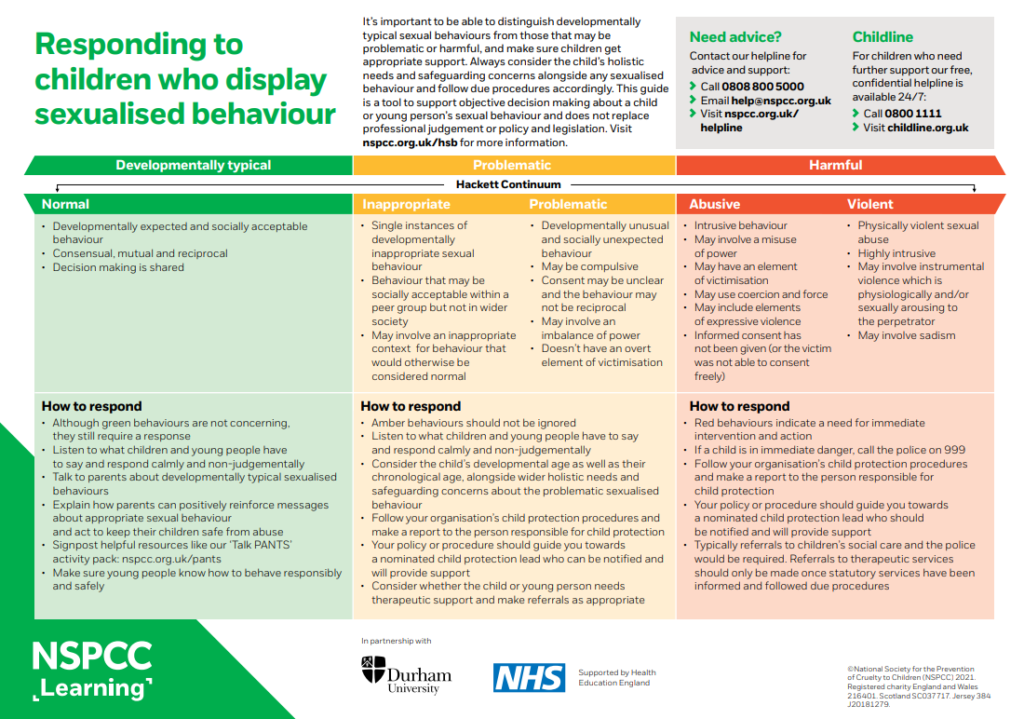
Developmentally typical (green) behaviours
Is developmentally expected and socially acceptable
Is consensual, mutual and reciprocal
Involves shared decision-making.
Problematic (amber) behaviours
Inappropriate behaviour
Single instances of developmentally inappropriate sexual behaviour.
Behaviour that is socially acceptable within a peer group but would be considered inappropriate outside that group.
Generally consensual and reciprocal.
May involve an inappropriate context for behaviour that would otherwise be considered normal.
Problematic behaviour
Developmentally unusual and socially unexpected behaviour.
May be compulsive.
Consent may be unclear and the behaviour may not be reciprocal.
May involve an imbalance of power.
Doesn’t have an overt element of victimisation.
Harmful (red) behaviours
Intrusive behaviour.
May involve a misuse of power.
May have an element of victimisation.
May use coercion and force.
May include elements of expressive violence.
Informed consent has not been given (or the victim was not able to consent freely).
Physically violent sexual abuse.
Highly intrusive.
May involve instrumental violence which is physiologically and/or sexually arousing to the perpetrator.
May involve sadism.
Where to go for further information and support?
In addition to the NYSCP toolkit, the following lists some services that have a range of resources, guidance and literature to provide professionals with further support on HSB.
However, should you have an immediate safeguarding concern about a child in North Yorkshire, go to the NYSCP Worried About a Child page for advice on the steps you need to take.
Local Support Services
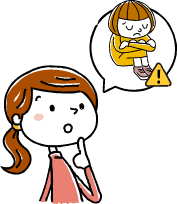
For more information on how to make a referral for support in North Yorkshire click here.
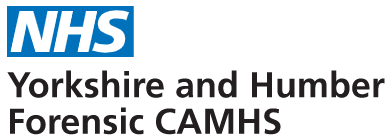
Forensic CAMHS is available to young people under the age of 18 living across the region and about whom there are questions regarding mental health or neuro disability who:
– present with a high risk of harm towards others, and about whom there is major family or professional concern
– and/or are in contact with the criminal justice system
– or are likely to enter secure care due to behaviour/presentation that can’t be managed elsewhere
Examples of presentations which may prompt professionals to refer to our service include: violent behaviours, arson/firesetting, harmful sexual behaviour which occurs in conjunction with other risk-related behaviour, animal cruelty or other complex high-risk behaviours which place the young person or others at risk of significant harm.
The service is community-based, and will also become involved with young people and their professional groups to support transitions both into and out of secure care hospital settings, secure welfare environments and custodial settings.
For further information on Forensic CAMHS, visit the Yorkshire and Humber Forensic CAMHS website here.
National Support Services

NSPCC Learning has a dedicated section on protecting children from harmful sexual behaviour which covers recognition, responding, prevention, direct work, legalisation and guidance and further resources on HSB. Visit NSPCC Learning here.
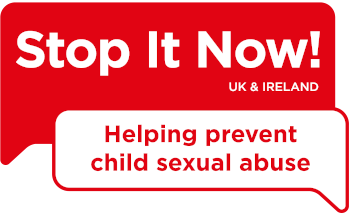
Stop It Now! offers support to professionals working in child sexual abuse prevention through a series of resources and has a range of resources on illegal online sexual behaviour. Visit Stop It Now! here
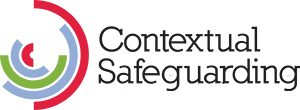
The Contextual Safeguarding Network carry out research, offers practice development and strategic engagement across the UK. They have a whole host of policy and practice resources created through the work they develop. Visit the Contextual Safeguarding Network here.
A safe place for teenagers worried about sexual behaviour.
Shore provides a safe and anonymous place for young people to get help and support. The aim of the website is to prevent harmful sexual behaviours among young people. Shore is a part of The Lucy Faithfull Foundation and is available for anyone who has questions about healthy sexual relationships, looking for reliable information to help them respond to someone else’s behaviour or wants to change their own behaviour.
https://shorespace.org.uk/
Child protection organisations and law enforcement agencies – including the NWG Network, Lucy Faithfull Foundation, Centre for Expertise on child sexual abuse, Marie Collins Foundation and the National Police Chief’s Council have produced an easy access service directory to help partners or family members of those who have been arrested for accessing child sexual abuse material find support and information.
As some family members may also want to find services for the person who has offended, it includes details of services for those who have accessed child sexual abuse material.
If you are working with a family needing support, or you need to support yourself, the list of Services Supporting Indirect Victims of Child Sexual Abuse Material Offending can be found below.
Service Directory (3).pdf (mariecollinsfoundation.org.uk)
Research Resources
This is an NYSCP summary of the key messages from research on children and young people who display harmful sexual behaviours. The second edition of the paper was published in February 2023 and is available to read in full at https://www.csacentre.org.uk/app/uploads/2023/02/Key-messages-from-research-Harmful-sexual-behaviour-2nd-edition-ENGLISH.pdf.
CSA Centre. (2018). Key Messages harmful sexual behaviour.
Sexualised Behaviours in Children Strategy – Responding to Harmful Sexual Behaviours 2024 – 27.
This strategy was developed in collaboration with a wide range of partners, following an audit conducted by the NSPCC and its findings, funded through the Community Fund provided by the Office of Police Fire and Crime Commissioner. The strategy defines, prevents, and intervenes early in harmful sexual behaviours, ensuring a consistent and effective response from partners across North Yorkshire. This joint approach coordinates our efforts, enabling us to work together to achieve the best possible outcomes for children and young people, and to continue building on this in future phases.
Harmful Sexual Behaviour OMG (One Minute Guide) for Parents and Carers
Acknowledgements
The NSPCC, Prof. Simon Hackett, Barnardo’s, Lucy Faithfull Foundation, Centre of Expertise on Child Sexual Abuse (CSA), and information taken from the Cambridgeshire and Peterborough Safeguarding Partnership Board.
Page Reviewed: April 2025












 View all our news
View all our news